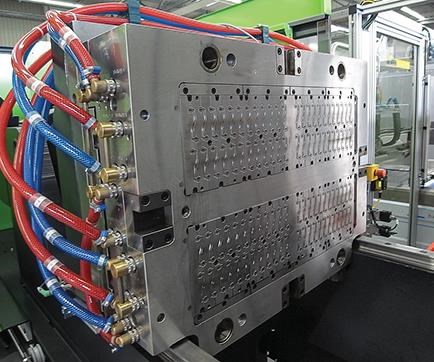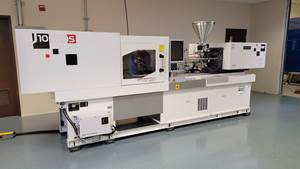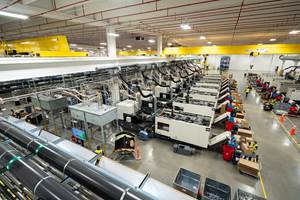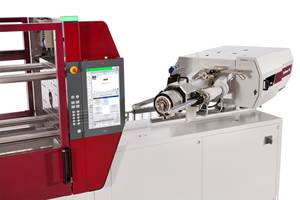Why Blum Went All Tiebarless
It Takes a Small Machine to Carry an Oversized Mold
One of the first adopters of tiebarless injection machines a quarter-century ago uses them exclusively, both here and in Europe. One reason is their ability to handle oversized molds with awkward projections on smaller presses.
For both Julius Blum GmbH and Engel Austria GmbH, it has been more than a quarter century of success with tiebarless injection presses. Engel (U.S. office in York, Pa.) pioneered the commercialization of this machine style 26 years ago and has sold more than 60,000 of these units to 10,000 customers worldwide.
One of its first tiebarless customers was Blum, a captive molder of hardware and fittings for cabinets and drawers in Voralberg, Austria. Blum has since standardized on Engel tiebarless presses for all its in-house molding in Austria and at its Blum, Inc. facility in Lowesville, N.C. Since 2000, that plant has installed 20 tiebarless Engel victory hydraulic and e-victory hybrid machines from 90 to 200 tons. “We are convinced we can master our challenges in a particularly economical way with this machine design,” says Christian Platzl, manufacturing engineering manager at Blum, Inc.
He sees the greatest advantage of tiebarless technology in fast mold setup. The U.S. plant makes at least six mold changes a week. The freely accessible mold area saves a lot of time. With no tiebars in the way, molds can be mounted directly from the side without having to remove core-pulls, and water-cooling lines can even be connected in advance. Maintenance technician Chris McCandless points out another advantage in ergonomics: “The clamping claws are easily accessible. We don’t need to stoop down to reach between the tiebars to set up the mold.”
LARGE MOLDS ON SMALL MACHINES
Blum designs and builds about half its molds at its Austrian headquarters. Very early on, the firm began to optimize its molds specifically for use in the tiebarless presses. Thus, some molds are taller vertically so that they protrude down into the ejection chute, while mechanical functions like servomotors for unscrewing threaded parts are often mounted so that they protrude beyond the left and right edges of the platens. “Only the cavities need to be located within the platen face,” explains Bill Pollard of Engel distributor ABC Lemke Plastics Machinery, based in Charlottesville, Va. The accompanying photos illustrate examples of how overhung molds can be carried easily by tiebarless clamps.
Thanks to the barrier-free mold area, very large molds can be mounted on relatively small presses. This benefits the molder because unit costs drop when machine size can be selected according to the actual clamp-force requirements rather than the mold size. Blum has realized this advantage increasingly as it has moved toward higher-cavitation molds—up to 128 cavities currently.
PLATEN PARALLELISM FOR PRECISION PARTS
Blum molds mostly small parts that are assembled before shipping. So that drawers, for example, glide open and closed smoothly, the components must fit together perfectly. Even microscopic surface imperfections or the slightest deviations in dimensions could impede functionality or lead to failure.
Thus Blum requires perfect platen parallelism, which it confirms with annual checks. Thanks to Engel’s design, the moving platen follows the mold precisely while clamping force is being applied, according to Pollard. He notes that the transferred force is very evenly distributed across the entire mold platen, resulting in extremely consistent wall thicknesses.
The most recent additions to the North Carolina plant were two hydraulic and two hybrid Engel victory machines. All four have servohydraulic “ecodrive,” which reportedly cuts energy consumption of hydraulic drives by up to 70%. For example, if no machine movements take place during the cooling phase, the motors stop and consume no energy. Less heating of the hydraulic oil results, so less oil cooling is needed.
That is a welcome feature in summer weather at Lowesville. “Cooling the production hall in summer is often quite a challenge,” says Blum supply-chain specialist Bill Gayer. “Production equipment that produces less heat is more than welcome.”
Related Content
Medical Grade Injection Molding Machine Line is Cleanroom Ready
JSW America says the J100ADS-110U medical grade molding machine has been optimized to prevent dust, rust and other contaminants.
Read MoreIPEX Opens Injection Molding Facility in North Carolina
The pipe and fittings manufacturer’s new 200,000-square-foot facility represents a $200 million investment and will create 150 jobs.
Read MoreFakuma 2023: More Details on New Machine Line
Wittmann Battenfeld has released more details on the new EcoPower B8X debuting at Fakuma (October 17-21; Friedrichshafen, Germany), which it previously announced.
Read More50 Years of Headlines … Almost
I was lucky to get an early look at many of the past half-century’s exciting developments in plastics. Here’s a selection.
Read MoreRead Next
Processor Turns to AI to Help Keep Machines Humming
At captive processor McConkey, a new generation of artificial intelligence models, highlighted by ChatGPT, is helping it wade through the shortage of skilled labor and keep its production lines churning out good parts.
Read MoreTroubleshooting Screw and Barrel Wear in Extrusion
Extruder screws and barrels will wear over time. If you are seeing a reduction in specific rate and higher discharge temperatures, wear is the likely culprit.
Read MoreUnderstanding Melting in Single-Screw Extruders
You can better visualize the melting process by “flipping” the observation point so that the barrel appears to be turning clockwise around a stationary screw.
Read More
















.png;maxWidth=300;quality=90)













